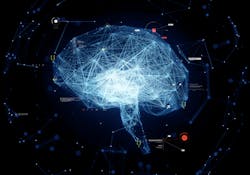Improving Automation’s Energy Efficiency with Neuromorphic Sensor Technology
While the term industrial automation typically refers to machines with the ability to perform highly-structured, pre-programmed tasks in place of human labor, the term industrial autonomy describes systems that are capable of adapting independently to diverse circumstances with minimal human intervention. For instance, an autonomous robot might be capable of learning to grip an unfamiliar object or navigate a new space without assistance from a human programmer. Artificial intelligence and machine learning provide the internal processing power necessary to enable this, but powerful external sensors are also needed to help robots and other automated technologies perceive and respond to their environments.
That’s why technologies such as “sensor fusion,” which grants a single sensor the ability to monitor multiple input types, are on the rise. These advanced sensor technologies are made possible by the exponential growth in computing capacity over the past several decades, which allowed more intelligence to be packed into smaller and smaller devices. However, the added processing power comes at a cost—namely, an increase in energy consumption.
To overcome this challenge, Fraunhofer-Gesellshaft, a major European applied research organization, has launched NeurOSmart, a joint research initiative with the Fraunhofer Institute for Photonic Microsystems. The project aims to use neuromorphic electronics, which are modeled on the operations of the human brain, to use less energy. As part of this project, neuromorphic sensors will be installed in robotic systems for use in manufacturing environments with the goal of increasing their energy efficiency.
The data processing performed by neuromorphic sensors is “realized by a novel analog computer memory technology that is also capable of performing computational operations when data is newly acquired in the system,” explained Michael Mensing, a scientist and project leader at the Fraunhofer Institute for Photonic Microsystems. "In practice, this is used to recognize objects and their behavior accurately and in real time. Until now, this mode of operation has required several separately developed components in computers and particularly energy-intensive communication between them.”
According to the Fraunhofer Institute for Photonic Microsystems, this new approach makes use of integrated electronics that allow for the parallel development of models for object recognition and classification that are specially adapted to individual sensors. This allows for a faster response time, increased data protection, and significant energy savings compared to current methods.
The NeurOSmart Initative has a project budget of eight million Euros and will operate for four years, during which it will attempt to integrate its neuromorphic sensor electronics with a complex light detection and ranging (LiDAR) system. LiDAR, a remote sensing method that uses light in the form of a pulsed laser to measure distances, is a vital component in numerous autonomous systems, and is often used to enable robotic navigation in diverse or changing environments
Other Fraunhofer-Gesellshaft organizations participating in this project include: The Institute for Silicon Technology, the Institute for Microelectronic Circuits and Systems, the Institute for Machine Tools and Forming Technology, and the Institute for Intelligent Analysis and Information Systems.
About the Author
David Miller
Former Senior Technical Writer

Leaders relevant to this article:
